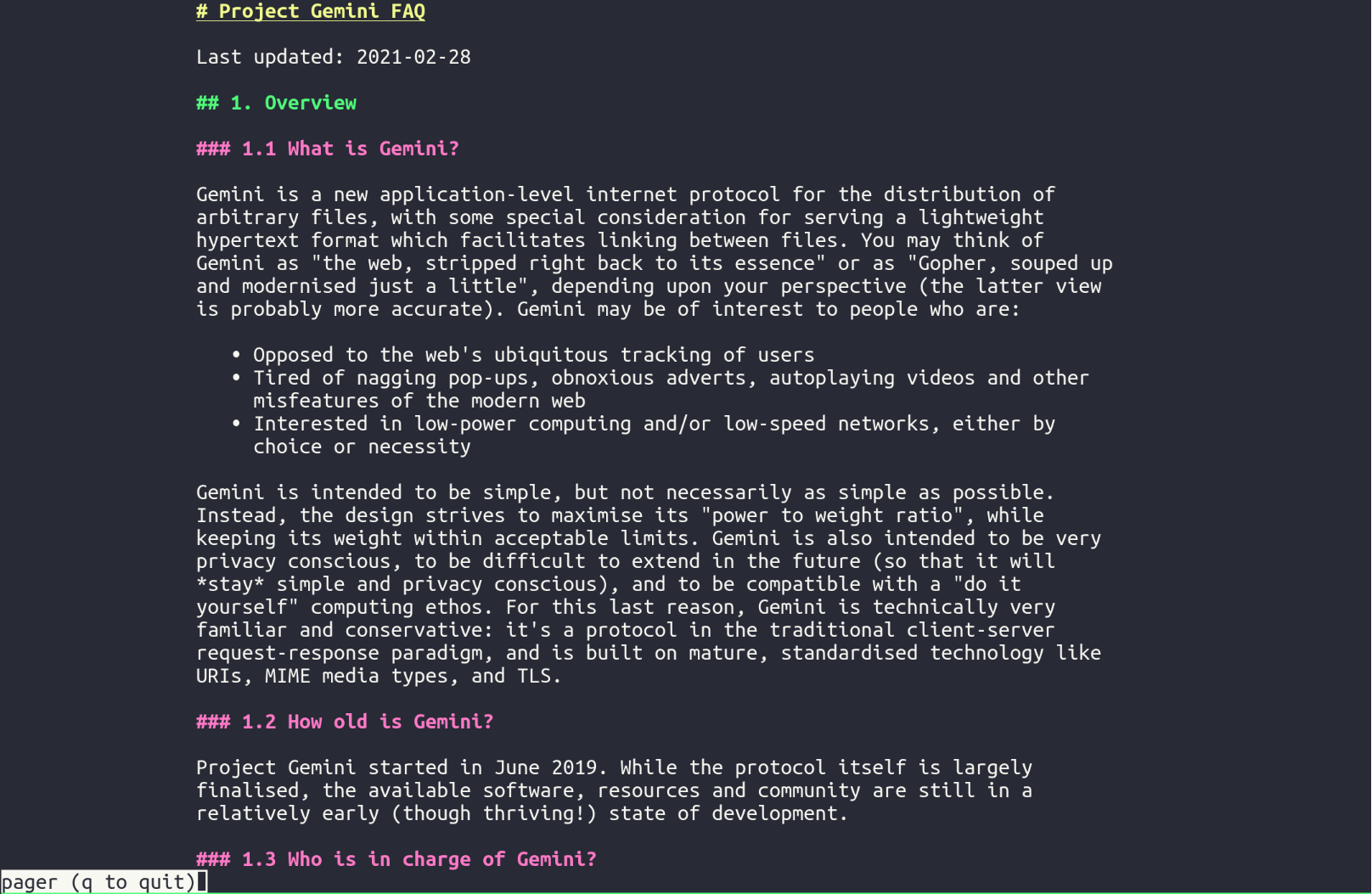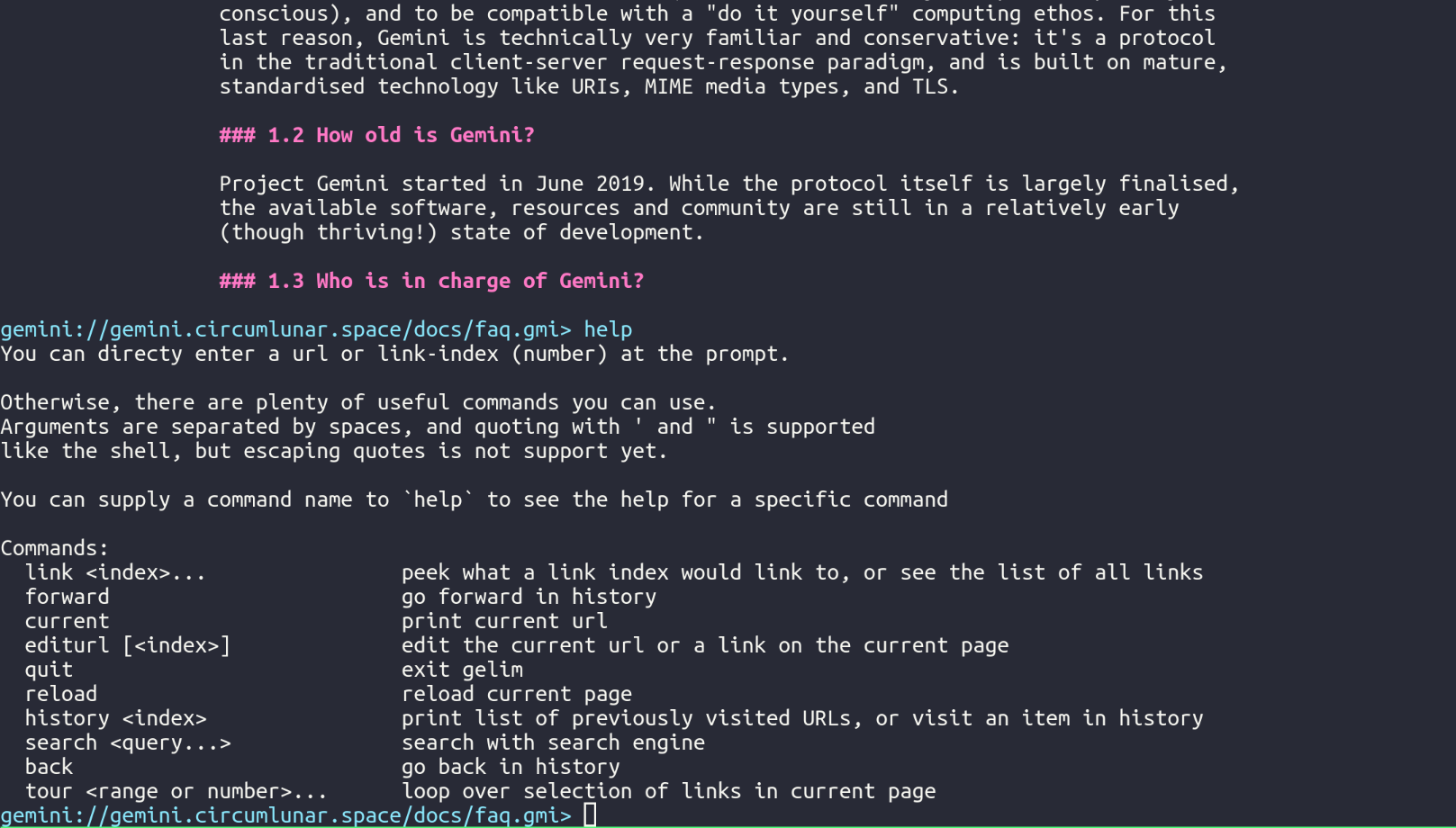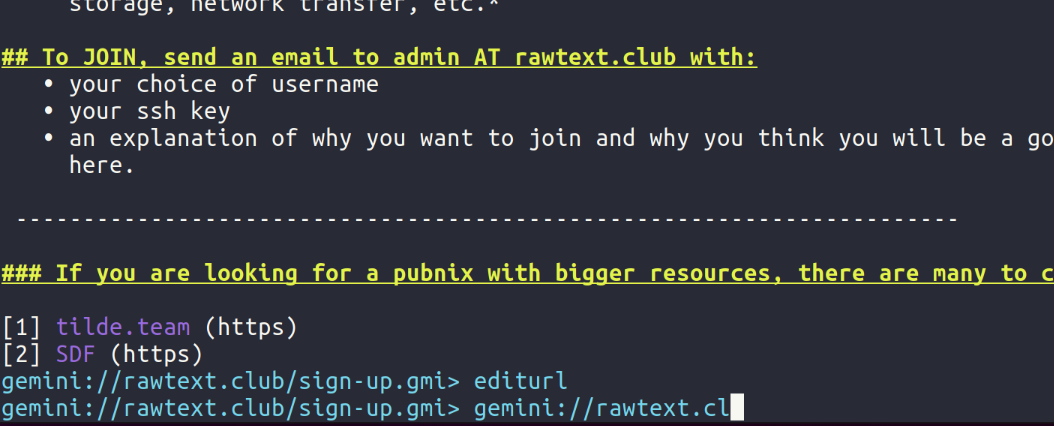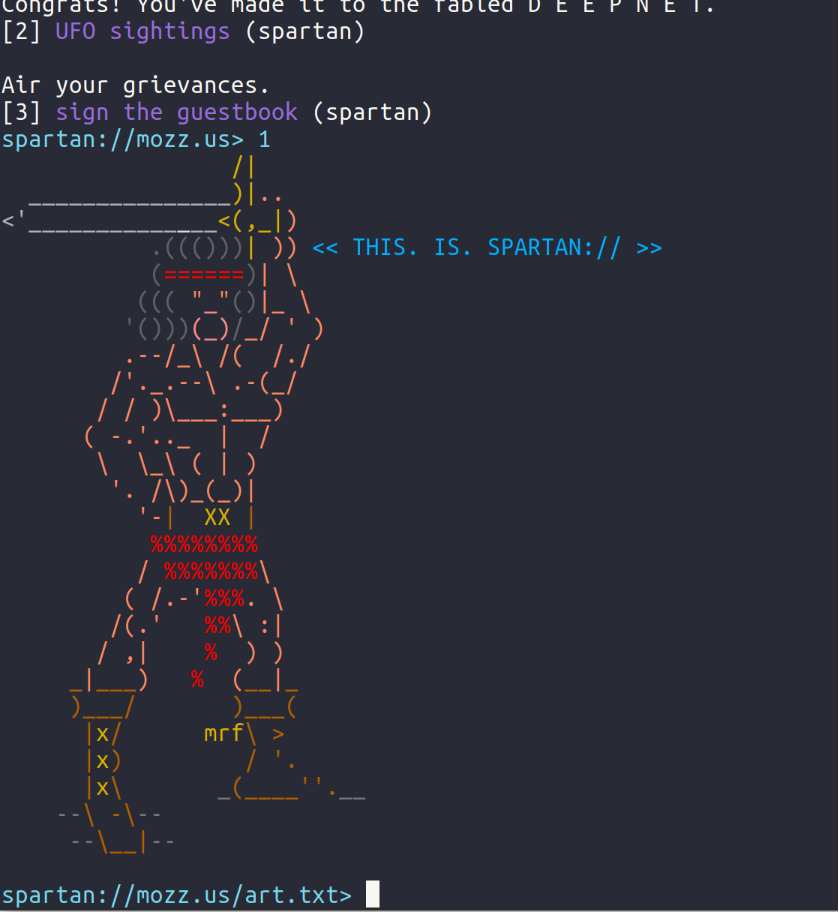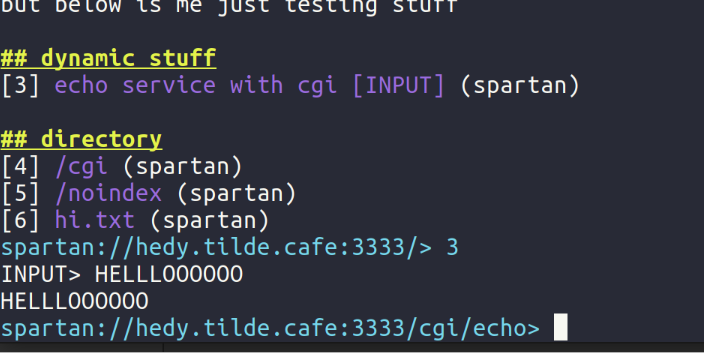Source (SourceHut) | Issues | Patches | Chat
A minimalist line-mode smolnet client written in go.
You get a simple line-mode browser interface to navigate URLs, plus a pager to view pages. Seriously, what more do you want?
Table of contents
- Features
- Install
- Usage
- Navigating a page/document
- Config
- A note about the pager
- CLI Options
- Screenshots
- Behavior details
- Remotes
- Bugs, features, feedback, and contributions
- Meta
- Searching from the command line
- Inputs from the command line
- Relative url at prompt
- Pager (requires less(1))
- Configuration
- Custom search URL
- Custom pager opts
- and more
- spartan:// protocol support
- nex:// protocol support
- Copying to clipboard
WARNING: the project is still in its early stages so do expect bugs and incomplete features, if you encounter them or would like to suggest an improvement, feel free to submit to the ticket tracker on srht or the one on github.
I plan to set up automated uploads of pre-built binaries to each release at some point in the future.
As of now you can either build from source or use go install.
go install git.sr.ht/~hedy/gelim@latestAll set! Skip to usage
Note that this method does not provide version information
First, install the dependencies:
- go (I think >=1.16)
- scdoc (for building manpage)
Clone the repo somewhere reasonable:
git clone https://git.sr.ht/~hedy/gelim
cd gelim
# Recommended to use latest pinned version, rather than @latest
# git checkout v0.0.0Build, optionally set PREFIX (default is PREFIX=/usr/local):
make
If all goes well, install gelim.
Remember to use the same PREFIX too.
sudo make install
# Or without sudo:
# $ make PREFIX=~/.local installIf you don't want to build the manual, you may put your hacker hat on, dive into
the Makefile, and copy the go build command used to compile gelim. This lets
you store version info accessible at --version.
Or you know what? Just a go build works too! The resulting binary will be
in the current directory.
Optionally verify your installation:
make checkinstall
The gelim binary would be sitting at $PREFIX/bin/ with manpage at
$PREFIX/share/man/ :)
-
"scdoc: command not found":
Make sure scdoc is installed before building. Or you can skip building the manpage and just run
go buildinstead. Check the Makefile for reference. -
Something to do with
io.ReadAll:Gelim requires go version >= 1.16.
If you're having other issues with installation, please send an email to the mailing list with errors/logs if available.
If you used the Makefile to install gelim the manpage should automatically be built and installed. See gelim(1)
I'm also planning to have a mirror of that manual hosted on man.sr.ht in the future for easy access.
Note that the manpage may not be the most recently updated. But new features and things like that will definitely be put in there once it's tested stable.
gelim gemini.circumlunar.space
This will bring you to less(1). You can use less to browse the page normally.
Note: if you see something like "-P is not an option", don't panic, this is because your system does not support one of gelim's default less options, you should skip over to the 'config' section below, and configure your lessOpts to remove the -P option, and any other your version of less doesn't have.
When you want to visit a link, you have to quit less first. Press q
The page will be fetched and you'll be in less again.
Now let's try something more interesting.
While you're at the prompt type:
rawtext.club
Say you don't have an account on RTC yet and would like to sign up.
Go to the bottom of the page, where the link to signing up is provided. Type G
Then, you have to quit the pager. Press q
Look for the link number that links to the sign up page, and enter it directly at the prompt. As of writing, the link number is 38, but keep in mind this number may change when you are trying this out.
38
And now you've decided to have a look at rawtext.club's values at the front page on more time. Unfortunately, the sign up page does not provide a link to go back to home. No worries, you can directly use the path (prefixed with . or /) at the prompt.
Let's try it out. Quit the pager (q), and type / and press enter
Voila, you're at the front page again!
Thanks for trying out this quickstart tutorial, there is still much to explore. Type in help
from the prompt and check out the commands, have fun!
Everything in page rendering is handled with less(1). less is called with opptions specified from your config file. gelim has no intervention in pre-processing any keys.
Hence, anything that works in less should work normally when less is called by gelim.
Useful navigation keys include: d/u/PgDn/PgUp/Space.
Useful keys for jumping to positions include: g/G.
In case you've never used a pager before, please keep calm under the
circumstance of realizing that ctrl-c/ctrl-d does not quit. Please press q
:P
For people on a Unix system it will look for configuration in ~/.config/gelim/config.toml.
Gelim follows XDG specification for deciding where to find config and where to store data files.
Though you do not need a configuration file to have gelim working.
# example config
prompt = "-->" # default: "%U" (the full url of
# the current page), more info
# below
startURL = "example.com" # default: ""
# will be put in LESS environment variable
lessOpts = "-FSXR~" # default: "-FSXR~ -P pager (q to quit)"
searchURL = "geminispace.info/search" # this is the default
clipboardCopyCmd = "pbcopy" # Example for MacOS. default = "" (unset)
maxRedirects = 5
index0shortcut = -1 # default: unset (0). an alias for link index 0clipboardCopyCmd:
Example for linux with xclip: xclip -sel c
Contents to be copied will be piped to the command as stdin.
maxRedirects:
- 0: Always confirm redirects
-
0: Ask to confirm redirects after a set number of redirects
- <0: Never confirm redirects. (Please see this section for behavior details)
index0shortcut:
How gelim should treat link index argument "0", please see this section for behavior details.
You can use a number of placeholders for your prompt (like PS1 in bash):
%U: Full url of current page including scheme (gemini://example.com/foo/bar)%u: Full url of current page without scheme (example.com/foo/bar)%P: Absolute path of the current url (/foo/bar)%p: Base path of the current url (bar)
Use %% for a literal percent character, and percent-prefixed option that is not supported
will be ignored and presented literally.
The query part of the URL will be stripped for all options, for security reasons. (If the
input was to be sensitive -- 11 status code -- the full query percent-encoded would be
printed as the prompt, which could mean revealing passwords, etc. Hence the query including
the ? is stripped.)
Here are some examples:
config resulting prompt
------- -----------------
"%U>" "gemini://example.com/foo/bar> "
"%P %%" "/foo/bar % "
"%z>" "%z> "
"%%%% $" "%% $ "
Gelim requires less(1) for paged output. If you don't have that installed, or is on windows, it will print the page directly and you'll have to scroll the page yourself (like AV-98). This is a bug and will be fixed in the near future.
Add --mouse (if your version of less supports it) to lessOpts option
in your config file.
Type /<your search query> when less is running. See less(1) for more
information.
~> gelim --help
Usage: gelim [FLAGS] [URL]
Flags:
-h, --help get help on the cli
-i, --input string append input to URL ('?' + percent-encoded input)
-I, --no-interactive don't go to the line-mode interface
-s, --search string search with the search engine (this takes priority over URL and --input)
-v, --version print the version and exit
For help on the TUI client, type ? at interactive prompt, or see gelim(1)
Examples:
Search
~> gelim -s "astrobotany"
Test your awesome, boring, classic, totally OG CGI scripts (exits immediately)
~> gelim example.org/cgi-bin/greet.sh -Ii 'world'
Hello, world!
~>
Use it in scripts to show outputs in stdout
~> cat <<EOF > python-help.sh
read -p "help> "
gelim do.hedy.dev/help/py -Ii "${REPLY:-help}"
EOF
~> bash python-help.sh
help> input
'Help on built-in function input in module builtins:
input(prompt=None, /)
Read a string from standard input. The trailing newline is stripped.
The prompt string, if given, is printed to standard output without a
trailing newline before reading input.
If the user hits EOF (*nix: Ctrl-D, Windows: Ctrl-Z+Return), raise EOFError.
On *nix systems, readline is used if available.'(Single quotes added on output to aid syntax highlighting.)
Submit your twtxt to antenna
~> gelim -I 'gemini://warmedal.se/~antenna/submit' -i 'gemini://do.hedy.dev/tw.txt'
Thank you for your submission! Antenna has now been updated.
Commands
Tour
Edit url
Spartan
Links
Search
Spartan input
A good way to master some software is to know how it works from the program's perspective.
Let's take a look at some UX details from various parts of gelim that could cause confusion.
Links on a page are numbered starting from 1. If a page has 3 links, the link indices are 1, 2, and 3.
You can simply type 1, 2, or 3 at the line-mode prompt directly to visit them.
Negative arguments
-1 specifies the last link, -2 the second-last link and so on.
This pattern is applied for ALL commands that take in a link index as argument, such as link, tour, history, editurl.
Multiple arguments
Commands link and tour supports multiple link index arguments, for example:
> link 1 2
> tour 3 4 5
What they do with those links is dependent on what the command is for.
Index 0
This is undefined by default, but can act as a shortcut, set in config
index0shortcut.
A hint is printed when you do not set this config value, and you try to use a
0 for link index:
> link 0
[ERROR] Behaviour for index 0 is undefined.
You can use -1 for accessing the last item, -2 for second last, etc.
Configure the behaviour of 0 in the config file.
Example: index0shortcut = -1, then whenever you use 0 it will be -1 instead.
This works for commands history, links, editurl, and tour.
Ranges
At the moment, ranges of link indices only work for command tour.
Ranges can be specified with an upper bound and a lower bound, separated by a comma. Both bounds can be omitted.
The default value of upper bound is the first link index, and the default value of lower bound is last link index.
Bounds are inclusive.
Naturally, if both bounds are excluded, all links on current page are selected.
gemini://gemini.circumlunar.space/> l
[...]
10 gemini://gemini.circumlunar.space/capcom/
11 gemini://rawtext.club:1965/~sloum/spacewalk.gmi
12 gemini://calcuode.com/gmisub-aggregate.gmi
13 gemini://caracolito.mooo.com/deriva/
14 gemini://gempaper.strangled.net/mirrorlist/
15 gemini://gemini.circumlunar.space/users/
gemini://gemini.circumlunar.space/> t 11,
Added 5 items to tour list
gemini://gemini.circumlunar.space/> t c
Cleared 5 items
gemini://gemini.circumlunar.space/> t ,
Added 15 items to tour list
The configuration option to set the maximum allowed automatic redirects is
maxRedirects. This is set to 5 by default (following RFC-2068), meaning gelim
will follow redirects 5 times, after which, if there are further redirects, user
will be prompted for what to do.
The command to view the history of redirects following current URL is
redirects.
Special values:
- 0: Ask for input for all redirects
- <0 (negative): Automatically follow all redirects
Due to implementation and resource limitations, gelim cannot practically follow
an infinite number of redirects, nor can gelim save the history of all previous
redirects and show them all in the redirects command.
The command shows a maximum of 10 most recent redirect URLs.
Once the number of unprompted redirects reaches 20, gelim aborts and prints the 10 most recent redirects.
If you wish, you can still copy the last URL from the output and visit the URL as normal.
What happens when the max number of redirects is reached
Consider the example where maxRedirects is set to 2 in the configuration file.
This is the behavior of following the redirhell torture test URL:
[...]
So, with that said, the first link is to the "Redirection From Hell" test, a test
of a series of temporary redirects, always. The second link is to the next test.
[1] Redirection From Hell
[2] 0023
gemini://gemini.thebackupbox.net/test/torture/0022> 1
[WARNING] Max redirects of 2 reached
1 gemini://thebackupbox.net/test/redirhell/20190
2 gemini://thebackupbox.net/test/redirhell/25942
Redirect to:
gemini://thebackupbox.net/test/redirhell/26941
[y/n]> y
[WARNING] Max redirects of 2 reached
1 gemini://thebackupbox.net/test/redirhell/9114
2 gemini://thebackupbox.net/test/redirhell/4356
Redirect to:
gemini://thebackupbox.net/test/redirhell/2582
[y/n]>
After 2 redirects, the user will be prompted and the count of redirects resets, meaning the user saying "y" to prompt is equivalent to the user opening a new link of the said URL.
If the total number of times the user gets redirected for a particular website
is 10, and maxRedirects is set to 3, the user will be prompted 3 times on
whether to follow a subsequent redirect.
- 3 redirects followed
- Continue? yes
- 3 redirects followed
- Continue? yes
- 3 redirects followed
- Continue? yes
- 1 redirect followed
- the page loads and is displayed
Here is an example for the behavior of redirects command, following the case
where maxRedirects is set to 2:
[...]
So, with that said, the first link is to the "Redirection From Hell" test, a test
of a series of temporary redirects, always. The second link is to the next test.
[1] Redirection From Hell
[2] 0023
gemini://gemini.thebackupbox.net/test/torture/0022> 1
[WARNING] Max redirects of 2 reached
1 gemini://thebackupbox.net/test/redirhell/32043
2 gemini://thebackupbox.net/test/redirhell/1544
Redirect to:
gemini://thebackupbox.net/test/redirhell/22150
[y/n]> n
gemini://gemini.thebackupbox.net/test/torture/0022> redir
1 gemini://thebackupbox.net/test/redirhell/32043
2 gemini://thebackupbox.net/test/redirhell/1544
gemini://gemini.thebackupbox.net/test/torture/0022>
You can use help <cmd> at the prompt to view usage information for a
particular command. If there's anything that is confusing or a pattern/behavior
that is hard to remember, let me know!
Of course, a last resort could be studying the source code directly, remember to look at the corresponding version which you built gelim from.
If there is any inconsistent behavior in gelim's interface, or if it does not follow what is described in the docs, please let me know using a method of contact described below.
Questions and general feedback:
- Send a (plain text) email to my public inbox.
- How to subscribe to the mailing list without a sourcehut account
- Join
#gelimon libera.chat IRC
Bugs and feature requests
- Submit a ticket to the tracker.
- You don't need a sourcehut account to subscribe or submit a ticket, here's how to do everything with email
- Or you can use the one on github if you prefer.
Pull requests, patches
- Send patches to my public inbox
- If you prefer pull requests instead, this is where PRs should go. You could also send PRs to my public inbox but I'll have to search up how to merge them (lol)
Gelim = "gemini" + "line-mode"-like interface
Pronunciation = Ge like "Jelly", lim like "limits"
(Imagine the Ubuntu jellyfish learning calculus)
once upon a time, a curious programmer stumbles upon ssh kiosk@gemini.circumlunar.space. then tries out bombadillo and amfora...
"how do I move? most pagers allow pressing space... oops that opens the command prompt"
"ok so I can press a number to go to that link... hmm how about 10, 11, 12 etc? is it like vim where it has a timeout for numeric keys? oops, looks like only single digits are supported..."
"wait so, single key press for single digit link indices, use a command prompt for all others? okay sure"
Tries out AV-98
"I love the interface!"
"wait why is it scrolling to the bottom of the page already? like our good-ol
cat?"
"I have to manually scroll my terminal screen? I have to reach for my mouse? otherwise I have to have a geeky window manager setup?"
"typing go command each time and navigating by relative URLs are a bit of a
pain"
...
"ok you know what: all links are commands. all link indices are commands. all
relative URL paths are commands. we shall put all content longer than screen's
height into a pager everyone's familiar with. just like git (CLIs), but
without typing the git!"
the programmer sets off to code...
